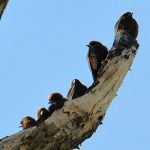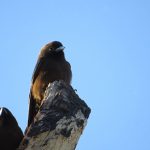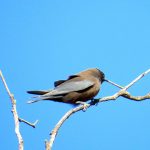LITTLE WOODSWALLOW
The Little Woodswallow is a diminutive creature, with a length of about 14 to 17 cm, making it the smallest member of the woodswallow family in Australia. It boasts a sleek, dark grey plumage, with a lighter grey or sometimes almost white belly. What truly sets it apart is the shimmering blue or green iridescence on its feathers when the sun catches them just right, a sight to behold amidst the Australian sunlit backdrop.
These birds are sociable creatures, often seen in small flocks. They have a distinctive, agile flight, with rapid wingbeats that allow them to deftly maneuver through the air. The Little Woodswallow is a sight to behold as it dances through the sky, chasing after insects with remarkable aerial grace.
Their habitat is as unique as they are, often found in the open woodlands and rocky outcrops, particularly in the northern and central parts of Australia. They have a preference for arid or semi-arid regions, where they can often be seen perching on dead branches or atop termite mounds, scanning the environment for their next meal.
Little Woodswallows form strong pair bonds and are known to be quite affectionate with their mates. During the breeding season, they build their nests in the hollows of trees or in the crevices of rocks, lining them with soft materials to prepare for their offspring. Both parents are involved in raising the young, a testament to their collaborative nature.
As you learn about the Little Woodswallow, it’s impossible not to be charmed by their social behavior and impressed by their adaptability to the harsh Australian environment. Yet, their story is also a gentle reminder of the delicate balance of nature. As with many of Australia’s native species, habitat destruction and changes in climate pose a threat to their way of life.
By sharing the story of the Little Woodswallow, we not only celebrate the incredible diversity of Australia’s wildlife but also underscore the importance of conservation efforts. It’s our collective responsibility to ensure that these birds, and countless other species, continue to grace the Australian skies for generations to come.




